Last Updated on August 3, 2024 by Carlos Alonso
Envelopes come in various sizes, tailored for different purposes. Among the most commonly used are the #9 and #10 envelopes. Understanding the differences between these two sizes is essential for efficient mailing, whether for personal or business use, such as sending invoices and correspondence. This article will explore their dimensions, uses, and practical considerations to help you make an informed choice in selecting the right business envelope.
Dimensions and Specifications
The primary difference between #9 and #10 envelopes lies in their dimensions. Here’s a comparative chart of their sizes:
| Envelope Type | Width (inches) | Height (inches) of the catalog envelopes |
|---|---|---|
| #9 | 3.875 | 8.875 |
| #10 | 4.125 | 9.5 |
Envelope size chart of #9 & #10 Envelopes
The #10 envelope is slightly larger than the #9 envelope, making it suitable for enclosing standard 8.5 x 11-inch paper folded into thirds.
The following chart visually represents the size comparison:
Typical Uses
- #9 Envelope Uses
- Commonly used as a return envelope, inserted into #10 envelopes.
- Suitable for smaller mailing needs, such as small documents or correspondence.
- #10 Envelope Uses
- The standard envelope for business letters.
- Fits an 8.5 x 11-inch sheet of paper folded into thirds, making it ideal for various business documents and correspondence, fitting perfectly in a standard size business envelope.
Envelope Paper Options: Natural, Linen, Regular, Offset, and Digital
When choosing #9 and #10 envelopes, the type of paper can significantly impact the look and feel. Here’s a brief overview:
- Natural and Linen: These offer a textured, elegant appearance, ideal for formal or high-quality communications.
- Natural: Smooth and classic.
- Linen: Textured and sophisticated, with a slight pattern.
- Regular: Standard smooth paper used for everyday mailing needs.
- Offset and Digital: These terms relate to the printing methods.
- Offset: Best for large print runs, offering consistent quality and color accuracy.
- Digital: Suitable for short runs, allowing for quick turnaround and variable data printing.
Catdi Printing offers these options for standard envelopes, ensuring high-quality choices to meet your specific needs.
Practical Considerations
Mailing Costs: Due to its smaller size, the #9 envelope may slightly reduce postage costs when used for return purposes. Bulk mailing with #9 envelopes can be more cost-effective for certain types of correspondence.
Storage and Handling: #9 envelopes, being smaller, are easier to store in bulk. However, #10 envelopes are more versatile for a range of business uses, offering a better fit for standard documents without folding too many times, unlike catalog and booklet envelopes.
Visual Impact: Larger envelopes like the #10 can hold more content and provide a more professional appearance for business correspondence. The additional space allows for a clearer and less cramped presentation of materials.
Mailing Efficiency and Security
Mailing Efficiency: Using the right envelope size, such as a business envelope, can significantly impact the efficiency of your mailing process. #10 envelopes, being the standard for business letters, are more likely to be recognized and processed efficiently by mail handlers.
Security: The security of the contents is another consideration. While both envelope sizes offer similar levels of protection, the larger #10 envelope allows for more secure enclosure of documents due to its increased size and ability to accommodate multiple folds and inserts without compromising integrity.
Environmental Impact
Material Usage: The size of the envelope affects the amount of paper used in its production, particularly in catalog envelopes. Smaller envelopes like the #9 use less material, which can be beneficial from an environmental perspective, especially when used in large quantities.
Recycling and Reusability: Both envelope sizes are typically made from recyclable materials. Choosing the appropriate size for the task can minimize waste and promote better recycling practices.
The choice between #9 and #10 envelopes depends on your specific needs. For business correspondence and standard documents, the #10 envelope is ideal. For return purposes and smaller enclosures, the #9 envelope is more suitable. Understanding these differences ensures efficient and effective mailing solutions, optimizing both cost and practicality for various applications.
By considering the dimensions, uses, key differences, practical considerations, and environmental impacts, you can make a well-informed decision on the best envelope size for your needs. Whether for personal use or business communications, choosing the right envelope size can enhance the efficiency and professionalism of your mailing efforts.
















